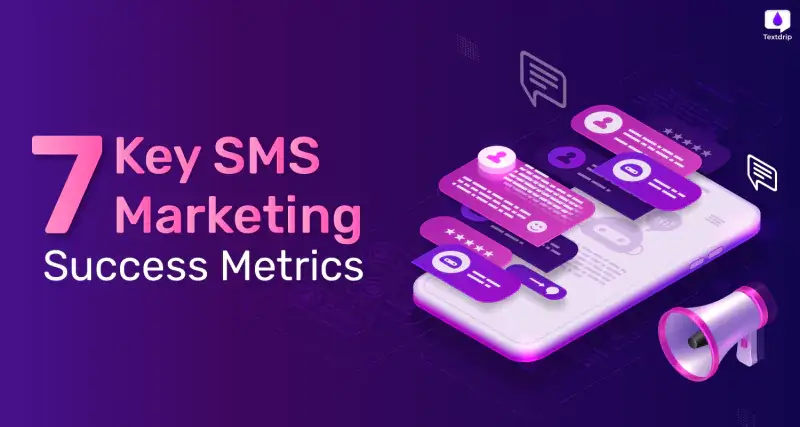
12 May 2023

Nicole Esters


12 May 2023

Nicole Esters
Text message marketing has become quite popular these days, and I have seen many brands leveraging this trend to supplement their overall digital marketing efforts. The reasons for the increased popularity of the SMS channel are clear,
According to one research, worldwide SMS marketing is expected to cross $84.9 billion by 2027. Another report found that spending on SMS marketing worldwide is $327.1, which is expected to grow to $339 billion in 2023 and almost double by 2024.
Woah! That’s too much. Don’t you think?
While you may spend a huge or small amount on SMS marketing, it’s vital to measure and track the success and performance of the same. Several SMS marketing metrics and benchmarks provide you with insights into what you’ve achieved against your end goal.
But why should you concern with tracking SMS marketing KPIs? Let me explain why and what metric to track:
Here’s why tracking SMS marketing benchmarks and KPIs is important:
Here, I present some essential SMS marketing metrics and benchmarks that you must track and improve:
Keeping a close eye on your contact list size and its growth rate gives you an idea about how big your contact list is and how many contacts subscribed or unsubscribed from receiving your SMSs.
It may not give you an idea of how many active users it includes but measuring it gives you a notion of how large your subscriber base is. Another relevant metric — list growth rate measures how quickly your subscriber list grows.
You can measure the same weekly, monthly, or yearly. A steady list growth rate refers to acquiring and retaining subscribers consistently. Here’s a formula to calculate the list growth rate:
List Growth Rate = [(No. of subscribers at the end of a period – No. of subscribers at the beginning) / (No. of subscribers at the beginning)] * 100

For example, you have 5568 subscribers right now compared to 5165 subscribers last month. So, your list growth rate becomes:
List Growth Rate = [(5568 – 5165) / (5165)] *100 = 7.80 %
Keeping an eye on the list growth rate allows you to find solutions to increase it when the same starts declining. You can also implement ways such as creating specialized landing pages or offering incentives to users to build your SMS subscriber list.
Regardless of where you invest, it boils down to one thing and that is how much revenue it helped generate for your business. ROI metric helps measure the impact of the investments you made. It’s one of the key SMS marketing KPIs that gives you insights into how well your efforts are generating returns.
Return on investment enables you to keep track of your profits and revenue generated through text message campaigns. It is a measure of returns (in dollar value) your text messages generated against the costs of sending them.
You can calculate the ROI of your SMS campaigns by subtracting the total cost from the revenue they generate. Here’s a formula to do so:
ROI = [(Total revenue generated – Total costs/investment) / Total costs/investment] * 100

For example, if an Health Insurance agency spent $35 on a subscription charge for SMS marketing software and purchased credit units worth $500 to send messages to a list of contacts. Now this investment helped them generate a revenue of $3752. Thus, your effective ROI becomes:
ROI = [(3752 – 535) / 535] * 100 = 601.31%
High ROI means your SMS campaigns are driving customers to purchase products or services from your brand. Tracking this key SMS marketing benchmark helps you analyze whether your SMS strategy needs optimization to improve outcomes.
Text message delivery rate is another important metric that offers how many messages were successfully delivered to recipients’ inboxes against how many were sent. The low delivery rate refers to several issues that are blocking your messages from getting to their intended recipients.
This can include issues such as,
You can measure the delivery rate using the following formula:
Delivery Rate = (No of messages delivered / No of messages sent) * 100

Let’s say 907 messages were delivered out of 1000 sent, the delivery rate becomes,
Delivery Rate = (907/1000) * 100 = 90.7%
To improve your delivery rate, clean up your list by removing invalid numbers using tools like Landline Remover . Also, refrain from sending repetitive content or sending messages frequently to avoid spam filters and improve your SMS deliverability rate .
Most times, you want users to take a certain action or reply to your text message after they’ve received it. For SMS campaigns to be successful , you expect recipients to respond in a variety of ways and interact with you actively. They can reply back, share the SMS, click on a link, or do something that counts as a response.
Response rate is a key metric that tells how engaged your SMS subscribers are with your text messages. You can measure the response rate using the following formula:
Response Rate = (Number of responses or actions taken / Total number of delivered messages) * 100

For example, if 102 users have responded or interacted with your message in any way out of the 907 delivered messages, the response rate becomes:
Response Rate = (102 / 907) * 100 = 11.25%
You can improve the response rate by creating compelling messages and crafting strong CTA or elements that inspire recipients to take action.
Users unsubscribing from your campaigns is an inevitable part of running automated or drip SMS campaigns. This could be because they no longer want to receive messages or are not interested in what you have to offer.
Regardless, tracking unsubscribe or attrition rate is a useful metric that provides you with an idea of how many customers are happy or unhappy with your texts. Here’s a formula to measure the unsubscribe rate:
Unsubscribe Rate = (Number of users unsubscribed in a period / Original number of subscribers at the start) * 100

Let’s say you had 3557 subscribers before the start of the last month and ended the month with 3429 subscribers. So, your unsubscribe rate becomes:
Unsubscribe Rate = [(3557-3429) / 3557] * 100 = 3.59%
The two most common reasons for users to unsubscribe are receiving too many SMSs and receiving the same message too frequently. Sending relevant and valuable content in a message sparingly will help you minimize the unsubscribe rate and maximize the SMS opt-in rate .
While response rate gives you an idea of how many customers respond to your texts, this metric gives you a deeper understanding of how many customers purchase your offerings. Customer acquisition cost refers to the amount of money spent to acquire a customer.
Here’s how you can measure the CAC:
CAC = (Total cost of running SMS marketing campaign / Total customers acquired through the campaign)

For instance, let’s say that a real estate agency spent around $1000 on SMS marketing for one month, which generated around 120 new customers for them. So, the effective CAC becomes:
CAC = 1000 / 120 = $8.33 per customer
High customer acquisition costs could mean that your customer segmentation is wrong or you’re targeting the wrong customers. So, you should properly segment your contact list to send tailored messages to optimize your CAC metric.
It’s possible that while sending an SMS, you may want to include a link to your website or landing page that you want customers to click. Click-through rate or CTR helps you calculate how many recipients click the link against the number of people who opened your message.
Here’s how you can measure this SMS marketing benchmark:
Click-through Rate = (Number of clicks your messages generate / Total number of opens)

While the open rate is a little complicated metric to track and measure for businesses, it also makes tracking CTR a little difficult. However, it’s not totally impossible as you can use UTM (Urchin Tracking Module) parameters of Google Analytics to add tags to your URLs.
This makes it easy to track how many people click on your links from your messages. Measuring this SMS marketing metric allows you to determine whether your SMS efforts are fruitful in bringing desired results.
Low CTR means your messages aren’t generating the desired results. To improve your CTR, optimize your text message content or make your CTA more compelling.
As you advance in your text message marketing, it’s essential that you track how your efforts are paying off. In this article, I presented some of the most effective SMS marketing metrics and KPIs that a business should keep a close eye on.
Tracking such metrics will help you get ahead in your SMS marketing game and optimize your campaigns to generate better results. Another way to get better results is to automate your SMS marketing campaigns through drip campaigns.
Textdrip is a great tool to automate your SMS drip campaigns and offers several metrics to track such as delivery rate and response rate. Get started today or contact our sales team for any query or more information.